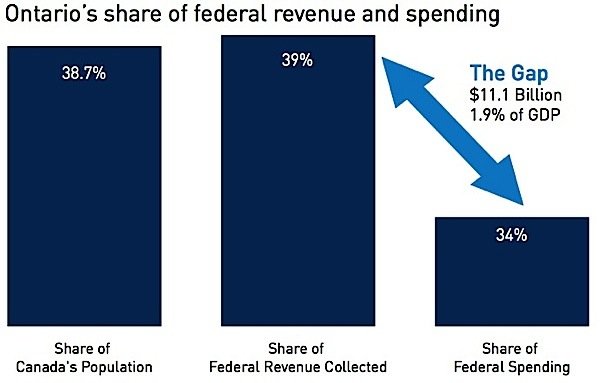A new study from the Mowat Centre at the University of Toronto argues that Ontario is at an economic disadvantage because of its having to transfer approximately $11 billion to the rest of Canada, a fiscal transfer that leaves the province “in worse shape rather than better.” Only the federal government can remedy the situation, and the report calls on that government, whoever will form it after October’s election, to create a new economic agenda for Ontario to solve a wide array of economic and social problems that, it says, are beyond the capability of the province to solve on its own.
Over the past ten years or so, the province has been buffeted by global forces and “disruptive change” that have left it dealing with wage stagnation, low productivity growth, a declining share of global exports and a “striking” decline in the manufacturing sector. Public debt has risen, while public service delivery has fallen behind. Precarious employment has become more widespread.
Despite all of these challenges presented by global economic “restructuring,” the report says Ontario has many strengths to build on\—a well-educated population, competitive business environment, safe, vibrant cities and a diversified economy with globally competitive firms and clusters. With all of these advantages, Ontario can seize “enormous opportunities” to drive economic growth and prosperity.
The structure of fiscal federalism, for example, continues to shift resources away from Ontario at a time when the province’s fiscal capacity and per capita GDP are below the national average. According to the latest available figures, Ontarians transfer approximately $11 billion a year to the rest of Canada, equivalent to nearly 2 per cent of the province’s GDP. That federal fiscal transfers leave Ontario in worse shape rather than better off is something that the federal government alone can change.
Not surprisingly, the most important problem to address is that of infrastructure. The importance of infrastructure spending is enormous: every $1 billion of infrastructure spending supports approximately 16,700 jobs for one year. Current levels of commitment to infrastructure spending fall short of “optimal” levels by 2 per cent of GDP, while the annual cost of traffic congestion just in the GTA already costs the economy $6 billion, the report claims. That could rise to $15 billion by 2031.
The report recommends that the federal government’s new $43 billion Building Canada Plan, announced in the 2013 budget, should be allocated on a per capita basis. If that were done, Ontario would qualify for an additional $1 billion of the funding.
Another major area tackled in the report is international trade. Foreign exports account for 31 per cent of the province’s GDP, with more than a quarter of all US-Canada trade flowing through Windsor. That flow needs to be opened up, the report argues, something that will require the removal of remaining barriers to trade and investment. Bi-lateral relations between the two countries are strained, however, threatened by “the politics of trans-border pipelines.”
Among the key issues needing to addressed as identified by the Mowat Centre report:
- Building productivity and trade through modern infrastructure
- Enhancing economic participation and opportunity for all Ontarians
- Attracting global talent and supporting immigrants to Ontario
- Strengthening innovation and productivity through coordinated and expanded business supports
- Facilitating trade and investment across Canada and international borders
- Responding to regional and cluster opportunities through targeted strategies

































